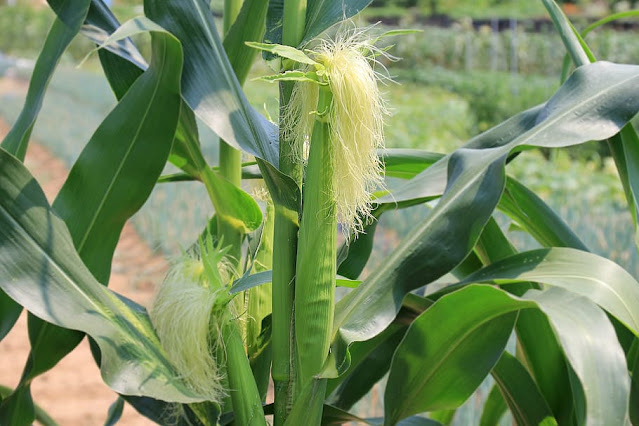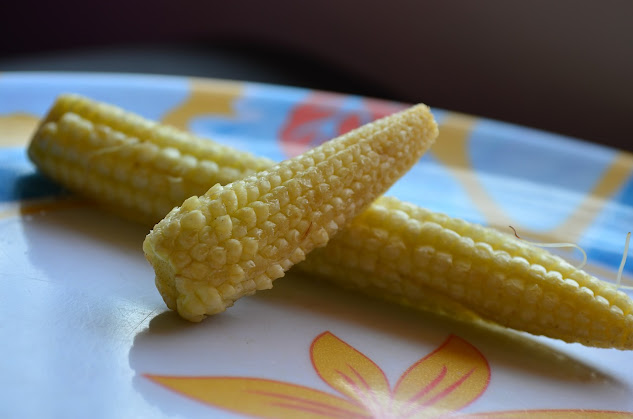Cultivation of Baby Corn; Zea mays L.
What is Baby Corn?
Baby corn represents the ear of corn (Zea mays L.) and the plant is harvested at a young stage of its growth, Maily when the silks have either not emerged or just be at an emerging stage, and there is no fertilization has taken place, ( 4 – 5 days after emergence ) depending on the cultivar is grown.
Salient Features of Baby Corn;
- Unfertilized cobs
- 6-11 cm long; 1.0-1.5 cm thickness
- Cream to light yellow
- Regular row arrangement
- Harvested 1-3 days of silk emergence.
- 3-4 crops in a year
Nutritious Value of Baby Corn ;
Baby corn is a good source of nutrients both in terms of quality and quantity. Baby Corn is not only provided proteins, vitamins, and iron but also it is one of the richest sources of phosphorus. ( fibrous protein ).
Half of a serving bowl with boiled baby corn contains approx.
Uses of Baby Corn ;
 |
| Crispy Baby Corn |
Baby corn is one of the important ingredient of the ChopSuey (Chinese dish), vegetable soups, deep-fried baby corn along with meat, rice, and other greeny vegetables. A large number of dishes may be prepared from baby corn.
 |
| Baby Corn along with Rice |
Baby corn is highly nutritive and its nutritive value is highly comparable to any common vegetable. Since only immature cob is harvested as the economic production, the crop meant as baby corn can be harvested within 50-55 days after sowing. Thus in the areas adjoining cities or other urban areas (peri-urban agriculture) multiple crops of baby corn can be raised which would fetch greater income to the farmers. Baby corn is one of the most important crops as a nutritious vegetable and as an export crop to earn valuable foreign exchange. After the harvesting, the young plants may be used as fodder for cattle feeds.
cultivation practices of baby corn ;
- Preference for an early maturing single cross hybrid with multiple cobs bearing ability and regular row arrangement
- Higher seed rate (22-25 kg/ha) with a high plant population (more than 83,000/ha)
- A higher dose of nitrogen application (150 to 180 kg/ha)
- Detasseling just after tassel emergence
- Harvesting unfertilized tender cobs within 1-3 days of silk emergence
Land Preparation for Baby Corn ;
Baby corn requires thorough disc ploughing followed by land leveling initially. Thereafter ridges and furrows are to be laid out with an inter-row distance of 65 cm. It is recommended to incorporate FYM @12-15 tonnes/ha• at the last ploughing. Good soil-to-seed contact, un-crusted soil, and optimal soil moisture help seedlings emerge.
Note;
a) Handle the seed with extra care if the seed coat attains a crack, the solutes may leak from the seed which may attract pathogenic fungi and result in germination losses as well may cause many seed-born diseases.
b) Rapid uniform seed emergence also promotes uniform maturity.
Criteria for Varietal Selection for Baby Corn Production ;
- Early maturating single cross hybrids
- Medium height and lodging resistance-Cultivars producing more than one ear per plant
- Responsive to a high dose of fertilizers
- No barrenness
- For better fodder quality, genotypes grown for baby corn cultivation must possess the stay-green traits.
- Straight leaves- To accommodate more plants per unit area, the erect leaf is a desirable trait. Length of the de-husked ear- Preferably not exceeding 10 cm with 1.0¬-1.5 cm diameter.
- A Husked to the dehusked ratio for the baby corn should be in the ratio of 5-6: 1.
- Harvesting period- The harvesting period should be within 10- 12 days in Kharif /spring and 20 days during winter.
- 3-4 pickings of baby corn from each plant should be taken to avoid deformity and the desired size and color should be maintained.
Climate Requirement for Baby Corn Cultivation ;
Most suitable temp. for baby Corn, healthy growth ranges from 22 to 30-degree Celcius Long spells of temperature more than 30 degrees celsius are not considered well fit for baby corn cultivation.
Sowing time for Baby Corn ;
It can be sown around the year except for the highly low-temperature days during the winter season.
Sowing Method for Baby Corn ;
For the big size of the field, the sowing should be done in blocks with seven days of time intervals. Baby corn should be sowed in the center of the ridges made at 60 cm apart during monsoon season.
Seed Rate for Baby Corn ;
- A little higher seed rate is recommended for baby corn in comparison to normal corn.
- A seed rate of 22kg /Hectare is recommended for Baby corn cultivation
- An optimum plant population of 85,000 to 1,10,000plants per hectare
Seed Treatment for Baby Corn ;
- Seeds should be treated with fungicides and insecticides before sowing to protect them from seed and soil-borne diseases and some insect-pests. The following pesticides should be used for the respective pests and diseases.
- For Seed borne diseases treat the seed with Bavistin/Captan @ 2 mg/kilogram of seed
- For termite and shoot fly treat the seed with imidacloprid @ 2ml /kilogram of seed or fipronil @ 4 ml/kilogram of seeds
- For enhancing the quality and yield of baby corn treat the seed with 3 to 4 packets of Azospirillum.
Fertilizer management in Baby Corn Field ;
- Apply 12 to 15 tonnes of FYM at the time of land preparation.
- The nutrient application should be based on soil test performance. Apply 120:60:0:25 kg/ha N, P, K, and ZnSO4.
- A full dose of phosphorus, potash, and zinc, and 30% N should be applied as a basal dose.
- The remaining dose of nitrogen should be applied in two splits at knee high and tasselling to avoid losses and to meet the requirement throughout the crop cycle.
- After the first/second picking apply 30 kg N/ha for harvesting good yield in subsequent pickings of the baby corn.
Irrigation management in Baby Corn Field ;
- Avoid waterlogging or water stagnation in the field. First irrigation should be applied very carefully. Water should not overflow on the ridges to avoid runoff and exposure of the seed for prey to the birds.
- The irrigation should be applied in furrows up to 2/3rd the height of the ridges. Irrigation should be given as and when required by the crop depending upon the rains and moisture-holding capacity of the soil. The Young seedlings up to the knee-high stage, silking stage, and picking stage are the most sensitive stages for water stress for the baby corn crop and irrigation must be given essentially at all these three stages.
- Light and frequent irrigations are desirable for the crop. During winter (mid-December to mid-February) soil should be kept wet to avoid frost injury in the baby corn.
Weed management in Baby Corn Field ;
- Broadleaf weeds and most of the grasses can be controlled by the preemergence spray of Atrazine @1.0-1.5 kg/ ha in 500-600 L of water.
- While spraying, the person doing the spray should move backward so that the Atrazine film on the soil surface may not be disturbed.
- Three nozzle booms may be ideally used for the proper ground coverage and it is also a time-saving tool.
- One to two hoeing is recommended for the aeration and uprooting of the remaining weeds.
- While doing hoeing, the person should move backward to avoid compaction of soil and to facilitate better aeration.
Intercropping in baby Corn Field ;
1)No adverse effects of intercrops on baby corn and vice-versa, rather, some of the intercrops help in improving soil fertility
2)Intercropping protects the baby corn crop from cold injury.
Intercrops protect the baby corn from the northern cold wind because baby corn is planted on the southern side and intercrops on the northern side of the ridge.
3)Mostly, short-duration varieties of intercrops are preferred for intercropping with baby corn.
4)The doses of fertilizers for the intercrops must be applied as per the recommendations in addition to the doses applied of fertilizers for baby corn cultivation.
5)In the Kharif season, cowpea for green pods and fodder purposes, urd-bean, mungbean, etc. can be intercropped with baby corn.
6)Number of intercrops are an option for the farmers but for commercial purpose, pea and potato can be taken on a large scale during the winter season
7)Short Duration crops like; Potato, green pea, rajma for green pods, palak, cabbage, cauliflower, sugar beet, green onion, garlic, methi, coriander, knol-khol, broccoli, lettuce, turnip, radish, carrot, french bean, celery, gladiolus, etc. have been successfully tried in the winter season
Detasseling of Baby Corn ;
. Harvesting of Baby Corn ;
The ears are harvested (45-50 days after emergence) when the silks are 1-2 cm long, i.e. within 1-2 days after silk emergence. Feed corn varieties are harvested at silking, while super sweet varieties may be harvested up to the time silks are about 5 cm long but still fresh. Ears quickly become too long and tough. The suitable time for harvesting of ears may be determined by sampling for size. Harvesting is usually done in the morning when the moisture is high and the temperatures are low. The picking of baby corn is to be done once in three days and generally 7-8 pickings are required depending on the genotypes used. Picking should be done daily in Kharif and on alternate days in the winter season within 1-3 days of silk emergence from the leaf sheath depending upon the variety. Harvesting should be done when baby corn silk comes out 2.0-3.0 cm from the top of ears, preferably in the morning or evening, when the baby corn moisture is highest and ambient temperature is low. In a single cross-hybrid plant, 3-4 pickings may be obtained.
The yield of Baby Corn ;
It depends on the potential of genotypes and climatic conditions. In a good crop, on an average of 15-19, q/ha dehusked baby corn can be harvested. Green fodder yield is about 300-400 q/ha which gives additional income to the growers.





